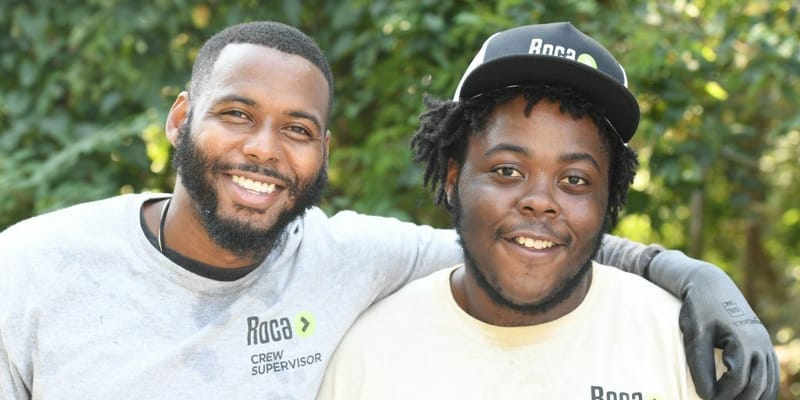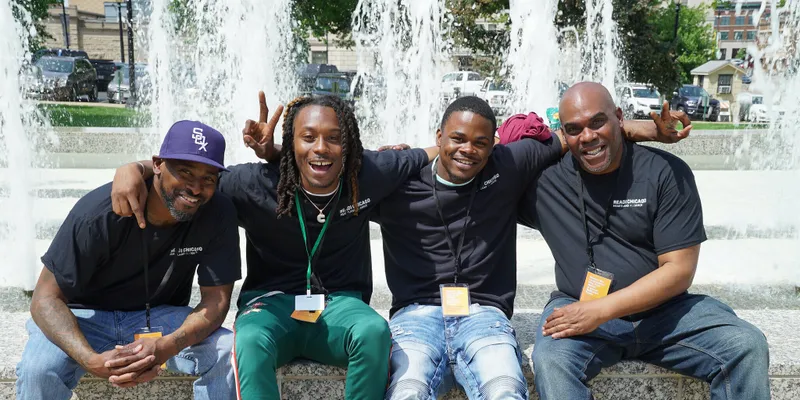Transitional employment and re-entry support
Strategy overview
- Creating an entry point to the labor market: Transitional job and re-entry support programs typically provide participants with short-term, paid jobs, subsidized and/or hosted by the program. Job-focused supports are often supplemented by wraparound vocational services, like career coaching and soft skills training. The primary goal of transitional employment programs is to facilitate a participant’s transition to unsubsidized, full-time employment.
- Supporting a range of populations: Many transitional employment and support programs are tailored to a specific population. Some, for instance, focus on individuals recently released from prison, while others focus on those most at risk of engaging in or falling victim to violence. Other programs may work with TANF recipients, people with disabilities, and individuals with no job history. The target population often dictates a program’s length: some are just three months, while others can last several years.
- Preparing for stable employment: Transitional employment and re-entry support programs are often delivered in phases. Initially, such programs typically provide workforce readiness training alongside supplemental support services (such as cognitive behavioral therapy, case management, and financial literacy courses). Then, participants are placed in a transitional employment role with daily pay; in many cases, transitional employment is provided by the program itself in areas like beautification or office administration. Finally, programs may offer referrals for full-time employment and ongoing coaching and job retention support to help participants achieve employment stability.
- Engaging with public, private, and nonprofit employers: In addition to providing workforce readiness training and transitional employment, many support programs also build a pipeline of employers to hire participants for full-time, unsubsidized work. Across evidence-based programs, employers come from a wide range of sectors, including nonprofits, the public sector, and private companies. Programs typically attempt to secure a diverse set of partner employers to fit the wide-ranging skillsets and personalities of participants.
Multiple syntheses of rigorous independent studies and evaluations demonstrate that transitional employment and re-entry support programs are associated with increased employment and income.
A 2022 research synthesis concluded that transitional and subsidized jobs were associated with increased employment and income among low-income adults, youth, unemployed individuals, TANF recipients, and individuals recently released from prison. Research also indicates that some models can be associated with reduced recidivism.
A 2020 research synthesis of subsidized employment programs found they increased participants' earnings and employment, and reduced recidivism; effects were strongest among those who had been out of the workforce for an extended period, were at higher risk of recidivism, or did not have a high school degree.
A 2016 randomized control trial found that two subsidized employment programs for TANF recipients had positive impacts on earnings and employment, with mixed impacts on benefit receipt.
Before making investments in this strategy, city and county leaders should ensure this strategy addresses local needs.
The Urban Institute has developed an indicator framework to help local leaders assess conditions related to upward mobility, identify barriers, and guide investments to address these challenges. These indicator frameworks can serve as a starting point for self-assessment, not as a comprehensive evaluation, and should be complemented by other forms of local knowledge.
The Urban Institute's Upward Mobility Framework identifies a set of key local conditions that shape communities’ ability to advance upward mobility and racial equity. Local leaders can use the Upward Mobility Framework to better understand the factors that improve upward mobility and prioritize areas of focus. Data reports for cities and counties can be created here.
Several indicators in the Upward Mobility Framework may be improved with investments in transitional employment and re-entry support. To measure these indicators and determine if investments in these interventions could help, examine the following:
Employment opportunities: Ratio of pay on an average job to the cost of living. These data are available from the Bureau of Labor and Statistics’ Quarterly Census of Employment and Wages.
Access to jobs paying a living wage: Employment-to-population ratio for adults ages 25 to 54. These data are available from the Census Bureau’s American Community Survey and the Bureau of Labor and Statistics’ Local Area Unemployment Statistics.
Opportunities for income: Household income at 20th, 50th, and 80th percentiles. These data are available from the Census Bureau’s American Community Survey.
Financial security: Share of households with debt in collections. These data are available from the Urban Institute’s Debt in America website.
Just policing: Number of juveniles arrested per 100,000. High rates of juvenile arrests provide a strong indicator of overall system involvement and over-policing. These data are available from the Federal Bureau of Investigation’s Crime Data Explorer.
Mathematica's Education-to-Workforce (E-W) Indicator Framework helps local leaders identify the data that matter most in helping students and young adults succeed. Local leaders can use the E-W framework to better understand education and workforce conditions in their communities and to identify strategies that can improve outcomes in these areas.
Several indicators in the E-W Framework may be improved with investments in transitional employment and re-entry support. To measure these indicators and determine if investments in this strategy could help, examine the following:
Access to health, mental health and social supports: Ratio of number workers or students to number of health, mental health, and social services FTE staff (for example, school nurses, psychologists, and social workers).
Expenditures on workforce development programming: The amount of funding dedicated to workforce development programs as a percentage of total educational funding in a state.
Industry-recognized credential: Percentage of program participants who have completed at least one industry-recognized credential.
Minimum economic return: Percentage of individuals that earn at least as much as the median high school graduate in their state plus enough to recoup their total net price plus interest within 10 years of completing their highest degree or leaving education.
Participation in work-based learning: Percentage of workforce training program participants who participate in a work-based learning opportunity before program completion.
- Center lived experience in program design and delivery: To better design workforce readiness training and the job placement process, programs should commit to hiring individuals with relevant lived experiences or partnering with community-based organizations who already have such individuals on staff. Those with lived experience similar to participants can provide foundational insight into the workforce readiness curriculum, identify employers or specific roles that would be a good fit, help recruit participants, and more.
- Create a robust referral network: To ensure the program reaches those most in need of support, develop a strong network of referral partners. For re-entry programs, agencies and individuals associated with the criminal justice system, such as the Department of Corrections, individual probation officers, and the local police department, can serve as strong sources of referrals. Public housing resident associations, social service agencies, and faith-based organizations can play a similar role.
- Identify target employers to hire program participants: Effective programs work to transition participants from subsidized to unsubsidized employment in as smooth a manner as possible. In addition to offering ongoing supports like coaching and skill-building workshops, work to build a reliable roster of employers who have demonstrated an interest in supporting and ultimately hiring participants. This often includes ensuring potential employers have the human resources and financial capacity necessary to hire and onboard a program participant.
- Invest in data collection and evaluation: Data analysis can help shape nearly all components of the program. For instance, programs can measure the effectiveness of particular types of training, track the success rates of employers in converting participants to full-time jobs, and use predictive modeling to match participants with jobs. Programs can then use such information to refine their models and better meet the needs of participants. In some cases, programs may partner with local universities, nonprofits, or criminal justice agencies for data sharing and/or increased analytical capacity.
Resources
Evidence-based examples
|
|
Outcome Area |
This ranking reflects how these approaches are scored in one of the major government- or philanthropy-led clearinghouse resources. For more: https://catalog.results4americ... |
|---|---|---|
|
Assists people exiting correctional facilities in reentering community life
|
Stable and healthy families Supportive neighborhoods |
Evidence varies across specific models |
|
AIM (Advocate, Intervene, Mentor) is a criminal justice intervention that pairs young adults on probation with an advocate-mentor.
|
Supportive neighborhoods |
|
|
Allegheny County Jail’s (ACJ) Reentry Program provides participants with a medium-to-high-risk of recidivism with support services both in jail and in the community.
|
Supportive neighborhoods |
|
|
Arches Transformative Mentoring is a group mentoring program for young adults (ages 16-24) on probation.
|
Supportive neighborhoods |
|
|
Provides highly structured job preparation and transitional employment to individuals immediately after they are released from prison
|
High-quality employment Stable and healthy families Supportive neighborhoods |
|
|
Seeks to advance behavior change among incarcerated individuals and those on probation
|
Stable and healthy families High-quality employment |
|
|
Prison and jail-based educational programs that provide basic reading, writing, and math, followed by other secondary education, to inmates
|
Stable and healthy families High-quality employment High school graduation |
|
|
Accelerated adult learning program that leads to a full high school diploma.
|
High-quality employment Supportive neighborhoods |
|
|
Harlem FamilyWorks (HFW) is a family and youth development initiative that supports formerly incarcerated individuals and their families.
|
Stable and healthy families |
|
|
A reentry program that provides incarcerated individuals with support services both prior to and after their release.
|
High-quality employment |
|
|
Intensive 2-year program combining transitional jobs with cognitive behavioral therapy, case management, coaching, and other support services
|
High-quality employment Supportive neighborhoods |
|
|
The Returning Citizens Stimulus (RCS) program provides direct cash transfers and reentry support services to formerly incarcerated individuals.
|
Supportive neighborhoods |
|
|
Intervention focused on addressing trauma, lowering involvement in criminal activity, and increasing employment
|
High school graduation High-quality employment Stable and healthy families Supportive neighborhoods |
|
|
Psychological, social, and educational interventions for incarcerated juvenile offenders to boost prosocial attitudes and behaviors and ultimately reduce recidivism
|
Supportive neighborhoods |
Evidence varies across specific models |



